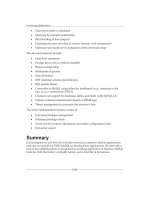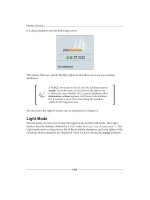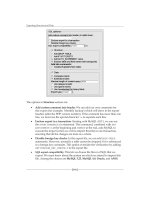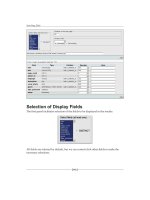Mastering javascript design patterns essential solutions for effective javascript web design by simon timms 2014
Bạn đang xem bản rút gọn của tài liệu. Xem và tải ngay bản đầy đủ của tài liệu tại đây (1.84 MB, 290 trang )
www.allitebooks.com
Mastering JavaScript
Design Patterns
Discover how to use JavaScript design patterns
to create powerful applications with reliable and
maintainable code
Simon Timms
BIRMINGHAM - MUMBAI
www.allitebooks.com
Mastering JavaScript Design Patterns
Copyright © 2014 Packt Publishing
All rights reserved. No part of this book may be reproduced, stored in a retrieval
system, or transmitted in any form or by any means, without the prior written
permission of the publisher, except in the case of brief quotations embedded in
critical articles or reviews.
Every effort has been made in the preparation of this book to ensure the accuracy
of the information presented. However, the information contained in this book is
sold without warranty, either express or implied. Neither the author, nor Packt
Publishing, and its dealers and distributors will be held liable for any damages
caused or alleged to be caused directly or indirectly by this book.
Packt Publishing has endeavored to provide trademark information about all of the
companies and products mentioned in this book by the appropriate use of capitals.
However, Packt Publishing cannot guarantee the accuracy of this information.
First published: November 2014
Production reference: 1151114
Published by Packt Publishing Ltd.
Livery Place
35 Livery Street
Birmingham B3 2PB, UK.
ISBN 978-1-78398-798-6
www.packtpub.com
www.allitebooks.com
Credits
Author
Project Coordinator
Simon Timms
Rashi Khivansara
Reviewers
Proofreaders
Amrita Chaturvedi
Simran Bhogal
Philippe Renevier Gonin
Lawrence A. Herman
Pedro Miguel Barros Morgado
Elinor Perry-Smith
Mani Nilchiani
Indexer
Commissioning Editor
Kunal Parikh
Hemangini Bari
Graphics
Sheetal Aute
Acquisition Editor
Meeta Rajani
Ronak Dhruv
Content Development Editor
Sweny M. Sukumaran
Technical Editor
Valentina D'silva
Disha Haria
Abhinash Sahu
Production Coordinator
Siddhi Rane
Nitesh Thakur
Copy Editor
Laxmi Subramanian
Cover Work
Nitesh Thakur
www.allitebooks.com
About the Author
Simon Timms is a developer who loves to write code. He writes in a variety of
languages using a number of tools. For the most part, he develops web applications
with .NET backends. He is very interested in visualizations and cloud computing.
A background in build and system administration keeps him on the straight and
narrow when it comes to DevOps.
He is the author of Social Data Visualization with HTML5 and JavaScript, Packt
Publishing. He blogs at and is also a frequent
contributor to the Canadian Developer Connection, where his latest series explores
evolving ASP.NET applications.
He is the President of the Calgary .NET User Group and a member of half a
dozen others. He speaks on a variety of topics from DevOps to how the telephone
system works.
He works as a web developer for Pacesetter Directional Drilling, the friendliest
performance drilling company around.
I would like to thank my wonderful wife for all her support and my
children who provided a welcome distraction from writing. I would
also like to thank the Prime team at Pacesetter for their sense of
humor and for putting up with me.
www.allitebooks.com
About the Reviewers
Amrita Chaturvedi is a PhD researcher in the Department of Computer
Science and Engineering at Indian Institute of Technology, Kanpur, Uttar
Pradesh, India ( />She was schooled (kindergarten to intermediate) at City Montessori School,
Aliganj, Lucknow, Uttar Pradesh, India. She received a Bachelor of Technology
degree in Information Technology from Institute of Engineering and Technology,
Lucknow, Uttar Pradesh, India and a Master of Technology degree in Information
Technology (with a specialization in Software Engineering) from Indian Institute
of Information Technology, Allahabad (Deemed University), Uttar Pradesh, India.
She has worked in Nucleus Software Exports Ltd., Noida, Uttar Pradesh, India as
a software engineer. She was also employed as a faculty in Institute of Engineering
and Technology, Lucknow, Uttar Pradesh, India. She has worked in user interface
design as a senior project associate at Indian Institute of Technology, Kanpur, Uttar
Pradesh, India. She was selected as the first female PhD student from Asia under
EURECA (European Research and Educational Collaboration with Asia) project
2009 to conduct research at VU University Amsterdam, the Netherlands. Her areas
of specialization are software engineering, software architecture, software design
patterns, and ontologies. Her research interests include software architecture and
design, ontologies-based software engineering, service-oriented and model-driven
architecture, semantic web, Internet technologies, and mobile agents.
She has given several talks and seminars as well as conference welcome/key notes
at international conferences. She has also earned various awards such as best paper
award for her research paper in an international conference, ACM SIGAPP award,
and has also been a Physics Olympiad topper. She has traveled several European,
North American, African, and Asian countries for educational/conference/research
purposes. She has teaching as well as research experience and has worked on several
implementation-based projects both jointly in a team as well as independently. She
has acted as a session chair and program committee member, as well as research
paper reviewer for various international conferences.
I would like to thank my incredible and beloved husband,
Bhartendu Chaturvedi, for his constant support.
www.allitebooks.com
Philippe Renevier Gonin has been an assistant professor at the
University of Nice Sophia-Antipolis (UNS), France, since 2005. He teaches
web technologies, software engineering (architecture, development),
and HCI (Human Computer Interaction).
In the research area, he works on connections between user-centered design
(for example, user and task models) and software engineering (for example,
component architecture and UI development).
Pedro Miguel Barros Morgado holds a Master's degree in Informatics and
Computing Engineering at FEUP (Faculdade de Engenharia da Universidade do Porto)
and did his master thesis on Object-Oriented Patterns and Service-Oriented Patterns.
Since 2009, he has been working with several different programming languages,
frameworks, and technologies, which included the main OO programming
languages such as PHP, Python, C/C++, Java, and JavaScript as well as web
languages such as HTML, JSON, and XML. He has worked with different database
technologies such as MySQL, PostgreSQL, Oracle SQL, and SQL Server and also with
different caching systems and search engines.
He has worked as an IT consultant in the banking field for a year, and built a
recommendation system (data mining and text mining) as a research assistant
at INESC (Technology and Science-Associated Laboratory) for a period of 1 year.
Finally, he focused on web projects as a technical lead at Rocket Internet AG, for
which he built scalable systems for FoodPanda, CupoNation, Camudi, and Lamudi.
Due to his experience, he has specialized in project management and product
development based on an e-commerce area. For more information, take a look
at his LinkedIn account at />
www.allitebooks.com
Mani Nilchiani is a developer, an artist, and a teacher based in Brooklyn, New
York. He holds an MFA degree in Design and Technology from Parsons The New
School for Design. He is a frontend engineer at The Daily Beast where he focuses on
UI Development, API design, integration, and architecture, and works as an adjunct
faculty at Parsons The New School for Design, where he teaches a graduate-level
curriculum of JavaScript development and design patterns. As a digital artist, he
approaches code as an expressive medium to create interactive, site-specific, and
generative works of art.
www.allitebooks.com
www.PacktPub.com
Support files, eBooks, discount offers, and more
For support files and downloads related to your book, please visit www.PacktPub.com.
Did you know that Packt offers eBook versions of every book published, with PDF and
ePub files available? You can upgrade to the eBook version at www.PacktPub.com and
as a print book customer, you are entitled to a discount on the eBook copy. Get in touch
with us at for more details.
At www.PacktPub.com, you can also read a collection of free technical articles,
sign up for a range of free newsletters, and receive exclusive discounts and offers
on Packt books and eBooks.
TM
Do you need instant solutions to your IT questions? PacktLib is Packt's online digital
book library. Here, you can search, access, and read Packt's entire library of books.
Why subscribe?
• Fully searchable across every book published by Packt
• Copy and paste, print, and bookmark content
• On demand and accessible via a web browser
Free access for Packt account holders
If you have an account with Packt at www.PacktPub.com, you can use this to access
PacktLib today and view 9 entirely free books. Simply use your login credentials for
immediate access.
www.allitebooks.com
www.allitebooks.com
To my wife, Melissa, and children, Oliver and Sebastian, who have been with me
every step of the way. Without their support, I would be but half a person.
Table of Contents
Preface1
Chapter 1: Designing for Fun and Profit
7
The road to JavaScript
7
The early days
8
A pause
10
The way of Gmail
10
JavaScript everywhere
13
What is a design pattern?
16
Antipatterns18
Summary20
Part 1: Classical Design Patterns
Chapter 2: Organizing Code
23
Chapter 3: Creational Patterns
43
Chunks of code
23
What's the matter with global scope anyway?
25
Objects in JavaScript
27
Build me a prototype
31
Inheritance34
Modules36
ECMAScript 6 classes and modules
40
Best practices and troubleshooting
41
Summary41
Abstract Factory
44
Implementation49
Builder
51
Implementation52
Table of Contents
Factory Method
55
Implementation55
Singleton58
Implementation59
Disadvantages60
Prototype60
Implementation61
Hints and tips
62
Summary63
Chapter 4: Structural Patterns
65
Chapter 5: Behavioral Patterns
89
Adapter65
Implementation67
Bridge
69
Implementation71
Composite
74
An example
75
Implementation76
Decorator
78
Implementation79
Façade80
Implementation81
Flyweight83
Implementation83
Proxy85
Implementation86
Hints and tips
87
Summary
87
Chain of responsibility
90
Implementation91
Command
94
The command message
95
The invoker
97
The receiver
98
Interpreter
99
An example
99
Implementation100
Iterator101
Implementation101
ECMAScript 6 iterators
103
[ ii ]
Table of Contents
Mediator103
Implementation104
Memento105
Implementation106
Observer
109
Implementation110
State112
Implementation113
Strategy116
Implementation117
Template method
119
Implementation121
Visitor123
Hints and tips
128
Summary128
Part 2: Other Patterns
Chapter 6: Functional Programming
131
Chapter 7: Model View Patterns
149
Functional functions are side-effect free
132
Function passing
132
Implementation134
Filters and pipes
136
Implementation137
Accumulators
139
Implementation140
Memoization141
Implementation142
Immutability144
Lazy instantiation
145
Implementation145
Hints and tips
147
Summary148
First, some history
Model View Controller
The MVC code
Model View Presenter
The MVP code
150
150
155
160
161
[ iii ]
Table of Contents
Model View ViewModel
The MVVM code
A better way to transfer changes between the model and the view
Observing view changes
Hints and tips
Summary
164
165
167
169
170
170
Chapter 8: Web Patterns
171
Chapter 9: Messaging Patterns
191
Chapter 10: Patterns for Testing
213
Sending JavaScript
171
Combining files
172
Minification
175
Content delivery networks
176
Plugins
177
jQuery177
d3179
Doing two things at once – multithreading
182
The circuit breaker pattern
185
Back-off186
Degraded application behavior
187
The promise pattern
188
Hints and tips
190
Summary
190
What's a message anyway?
192
Commands193
Events194
Request-reply
196
Publish-subscribe
199
Fan out and fan in
202
Dead-letter queues
205
Message replay
207
Pipes and filters
208
Versioning messages
209
Hints and tips
210
Summary211
The testing pyramid
214
Test in the small with unit tests
214
Arrange-Act-Assert216
Asserts217
[ iv ]
Table of Contents
Fake objects
218
Test spies
219
Stub220
Mock222
Monkey patching
223
Interacting with the user interface
224
Browser testing
224
Faking the DOM
225
Wrapping the manipulation
226
Build and test tools
227
Hints and tips
227
Summary228
Chapter 11: Advanced Patterns
229
Chapter 12: ES6 Solutions Today
241
Dependency injection
229
Live postprocessing
233
Aspect-oriented programming
234
Macros238
Hints and tips
239
Summary240
TypeScript241
The class syntax
242
The module syntax
243
Arrow functions
244
Typing246
Traceur248
Classes249
Default parameters
250
Template literals
251
Block bindings with let
252
Async254
Conclusion255
Hints and tips
255
Summary256
Appendix: Conclusion
257
Index261
[v]
Preface
JavaScript is starting to become one of the most popular languages in the
world. However, its history as a bit of a toy language, means that developers
are tempted to ignore good design. Design patterns are a great tool to suggest
some well-tried solutions.
What this book covers
This book is divided into two main parts, each of which contains a number of
chapters. The first part of the book, which I'm calling Part 1, covers the classical
design patterns, which are found in the GoF book. Part 2 looks at patterns, which are
either not covered in the GoF book or the ones that are more specific to JavaScript.
Chapter 1, Designing for Fun and Profit, provides an introduction to what design
patterns are and why we are interested in using design patterns. We will also talk
about the history of JavaScript to give a historical context.
Chapter 2, Organizing Code, explains how to create the classical structures used
to organize code: namespaces or modules and classes as JavaScript lack these
constructs as first class citizens.
Chapter 3, Creational Patterns, covers the creational patterns outlined in the Gang of
Four book. We'll discuss how these patterns apply to JavaScript, as opposed to the
languages which were popular at the time when the Gang of Four wrote their book.
Chapter 4, Structural Patterns, examines the structural patterns from the Gang of Four
book following on our look at creational patterns.
Chapter 5, Behavioral Patterns, covers the final set of patterns from the Gang of
Four book that we'll examine. These patterns govern different ways to link
classes together.
www.allitebooks.com
Preface
Chapter 6, Functional Programming, explains some of the patterns which can be found
in functional programming languages. We'll look at how these patterns can be used
in JavaScript to improve code.
Chapter 7, Model View Patterns, examines the confusing variety of different
patterns to create single-page applications. We'll provide clarity and look at
how to use libraries which use each of the existing patterns, as well as create
their own lightweight framework.
Chapter 8, Web Patterns, covers a number of patterns which have specific applicability
to web applications. We'll also look at some patterns around deploying code to
remote runtimes such as the browser.
Chapter 9, Messaging Patterns, explains messaging which is a powerful technique
to communicate inside, and even between, applications. We'll also look at some
common structures around messaging and discuss why messaging is so useful.
Chapter 10, Patterns for Testing, focuses on some patterns which make for easier
testing, giving you more confidence that your application is working as it should.
Chapter 11, Advanced Patterns, includes some patterns, such as aspect-oriented
programming, that are rarely applied in JavaScript. We'll look at how these
patterns can be applied in JavaScript and discuss if we should apply them.
Chapter 12, ES6 Solutions Today, discusses some of the tools available to allow you
to use features from future versions of JavaScript today. We'll examine Microsoft's
TypeScript as well as Traceur.
Appendix, Conclusion, covers what you have learned, in general, in the book, and you
will be reminded of the goal of using patterns.
What you need for this book
There is no specialized software needed for this book. JavaScript runs on all modern
browsers. There are standalone JavaScript engines written in C++ (V8) and Java
(Rhino), and these are used to power all sorts of tools such as Node.js, CouchDB,
and even Elasticsearch. These patterns can be applied to any of these technologies.
[2]
Preface
Who this book is for
The intended audience is developers who have some experience with JavaScript,
but not necessarily with entire applications written in JavaScript. Also, developers
who are interested in creating easily maintainable applications that can grow
and change with need.
Conventions
In this book, you will find a number of styles of text that distinguish between
different kinds of information. Here are some examples of these styles, and an
explanation of their meaning.
Code words in text, database table names, folder names, filenames, file extensions,
pathnames, dummy URLs, user input, and Twitter handles are shown as follows:
"The next item of interest is that we need to make use of the this qualifier to address
the greeting variable from within the doThings function."
A block of code is set as follows:
var Wall = (function () {
function Wall() {
console.log("Wall constructed");
}
return Wall;
})();
Structures.Wall = Wall;
When we wish to draw your attention to a particular part of a code block, the
relevant lines or items are set in bold:
var Wall = (function () {
function Wall() {
console.log("Wall constructed");
}
return Wall;
})();
Structures.Wall = Wall;
Any command-line input or output is written as follows:
npm install –g traceur
[3]
Preface
New terms and important words are shown in bold. Words that you see on
the screen, in menus or dialog boxes for example, appear in the text like this:
"clicking the Next button moves you to the next screen".
Warnings or important notes appear in a box like this.
Tips and tricks appear like this.
Reader feedback
Feedback from our readers is always welcome. Let us know what you think about
this book—what you liked or disliked. Reader feedback is important for us as it helps
us develop titles that you really get the most out of.
To send us general feedback, simply e-mail , and mention
the book's title in the subject of your message.
If there is a topic that you have expertise in and you are interested in either writing
or contributing to a book, see our author guide at www.packtpub.com/authors.
Customer support
Now that you are the proud owner of a Packt book, we have a number of things to
help you to get the most from your purchase.
Downloading the example code
You can download the example code files from your account at http://www.
packtpub.com for all the Packt Publishing books you have purchased. If you
purchased this book elsewhere, you can visit />and register to have the files e-mailed directly to you.
You can also download the example code files for this book from GitHub at
/>
[4]
Preface
Errata
Although we have taken every care to ensure the accuracy of our content, mistakes do
happen. If you find a mistake in one of our books—maybe a mistake in the text or the
code—we would be grateful if you could report this to us. By doing so, you can save
other readers from frustration and help us improve subsequent versions of this book.
If you find any errata, please report them by visiting />submit-errata, selecting your book, clicking on the Errata Submission Form link,
and entering the details of your errata. Once your errata are verified, your submission
will be accepted and the errata will be uploaded to our website or added to any list of
existing errata, under the Errata section of that title.
To view the previously submitted errata, go to />content/support and enter the name of the book in the search field. The required
information will appear under the Errata section.
Piracy
Piracy of copyrighted material on the Internet is an ongoing problem across all
media. At Packt, we take the protection of our copyright and licenses very seriously.
If you come across any illegal copies of our works in any form on the Internet, please
provide us with the location address or website name immediately so that we can
pursue a remedy.
Please contact us at with a link to the suspected
pirated material.
We appreciate your help in protecting our authors and our ability to bring you
valuable content.
Questions
If you have a problem with any aspect of this book, you can contact us at
, and we will do our best to address the problem.
[5]









